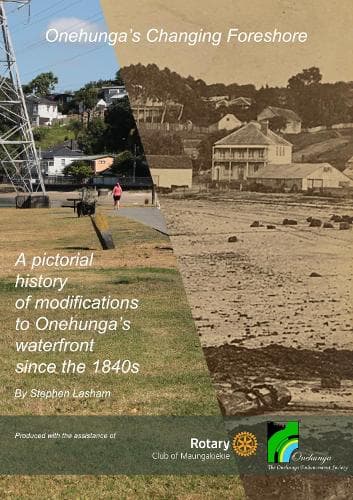Stephen LashamAuthor
Stephen Lasham has been a resident in Onehunga for the past 25 years, living in Quadrant Road and having a close connection to the Manukau Harbour through his 15 years of involvement as a leader at Aotea Sea Scouts. Here he introduced his three children to Scouting, became a leader and joined the group’s committee. It was through the Sea Scouts that his interest in the Onehunga Foreshore history was piqued. Due to the actions of the New Zealand Transport Agency in relation to the East West Link project, he took on the task of building the Sea Scouts’ case in opposition to the radical changes proposed around the Sea Scout building on Orpheus Drive. The main area of concern was the proposed changes to Gloucester Park which would have undoubtably ended the Sea Scouts’ ability to run their program at their hall and would have prevented future utilisation of the park area used for their activities. The resulting investigation led the author to join The Onehunga Enhancement Society (TOES), and the Manukau Harbour Restoration Society (MHRS). Through the encouragement of Jim Jackson, the then chairman of both these groups, the author become involved with the Community Plan campaign promoting a better alternative solution to that proposed by the NZTA. It led the author to the discovery that the Unitary Plan had blocked TOES desired future restoration of the foreshore between Taumanu Reserve and the Port of Onehunga with the introduction of the Outstanding Natural Feature (ONF), designation placed on Gloucester Park and more importantly, its foreshore. Researching for Aotea Sea Scouts’ objection to the East West Link also meant delving back into the group’s history, something that was recorded in minutes, old letters, and log books held by the group, along with other sources. The group has a long history of dealing with the various transport agencies throughout its existence. This is another fascinating work as yet waiting to be published, adding to the Scouting history of Onehunga since Scouting started in New Zealand in 1908. Researching for both these projects highlighted to the author just how radically the foreshores of Onehunga had been changed. Many publications touch the surface of this subject, and many in recent times; the subject was of vital significance to the NZTA in developing their analyses for the East West Link project and prior projects relating to State Highway 20. This work hopefully goes some way to illustrating the changes, highlighting just how much change has taken place and how much damage has been done. The author acknowledges that Onehunga has other stories, and hopes he has not strayed too much into others’ territories, but hopes through your reading of this work that you will now have a better understanding and maybe join the cause for further restoring the lost foreshores of Onehunga and improving the quality of the Manukau Harbour as a whole.
